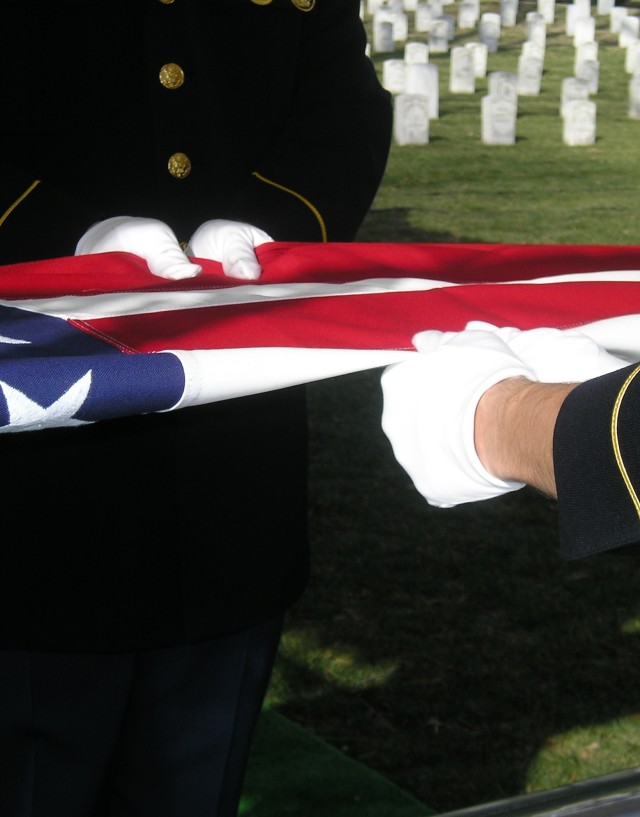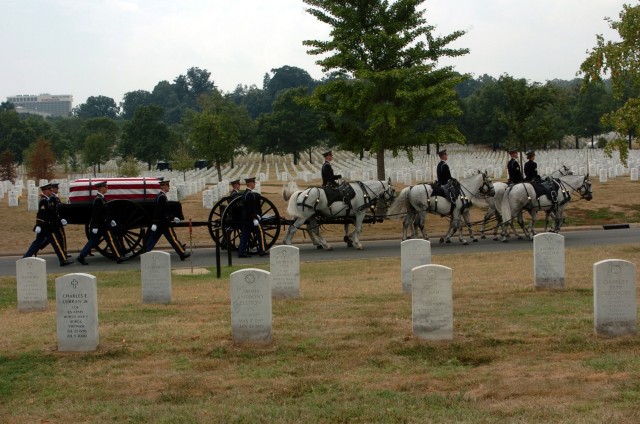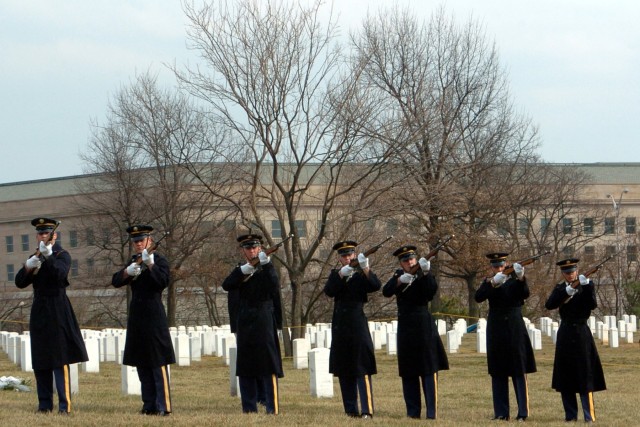The scene has played out in countless movies: A mother and father are eating dinner when they hear a knock at the door. The father answers, separated from a lone Soldier by a screen door. The mother joins her husband at the door, the camera zooms in on the Soldier, and music drowns out what he says.
The mother throws herself into her husband's arms, and the Soldier's lips form the words, "I'm so sorry."
That is how the movies leave the family, alone and grieving. But that's only in the movies.
In reality, when a Soldier is killed in combat, an entirely different scenario transpires, according to Soldiers at the Casualty and Mortuary Affairs Operations Center. The process of notifying a family about the death of a loved one is one action in a series of events that begin before a casualty-notification officer makes the solemn walk to a family's front door.
When a Soldier is killed in-theater, members of the CMAOC receive a preliminary message, said Lt. Col. Bob Amico, chief of training and media development. "We get a 'heads-up' message from in-theater regarding deaths. While the command in-theater is verifying every detail of the death, the CMAOC assigns a case manager, who notifies the Casualty Assistance Center closest to the family."
The Army has 27 CACs in the continental United States, and six overseas. The CACs are responsible for the administrative functions of casualty operations and mortuary affairs, said Lt. Col. Brenda Hughey, CMAOC's Case Management Branch operations officer. They are usually operated on military installations, and assign and train casualty-notification and casualty-assistance officers.
Once the CMAOC receives the official initial report of a Soldier's death from the Theater Casualty Area Command in Kuwait, it is forwarded to the local CAC. A CNO and a CAO are assigned, said Sgt. 1st Class Norman Campbell, NCOIC of the CMAOC's Notification Cell. Barring extenuating circumstances, the family must be notified within four hours of the time the CMAOC receives the initial casualty report.
A two-person team always delivers the news no one wants to deliver to a parent, husband or wife, said Sgt. 1st Class Robert Ormsbee of the Case Management Branch. The duty carries with it the unimaginable burden of being the person who must explain to the family that their loved one is not coming home alive.
"In most cases a chaplain will be one of the two people to visit the family," he added. The chaplain is there to support both the family and the CNO. If a chaplain is not available, another Soldier - a staff sergeant or above - will be the second member.
"We used to only assign one CNO and one CAO to the primary next of kin," Amico said. "For example, if a Soldier was married, there would be a CAO for the husband or wife. We now also provide a CNO and a CAO to the parents.
"Throughout the process, the CAOs will communicate with one another to ensure both parties are represented," he said. The CAOs work together in those situations to coordinate travel, lodging and other logistics so the family members have less to consider.
Before being appointed, a CNO or CAO must undergo comprehensive training, said Amico, who added that the program has been refined in recent years.
"The key piece of training that was missing in the past was the emotional aspect of this duty," Amico said. As a result, the military has developed emotionally based scenarios designed so CNOs and CAOs get an idea of what to expect during the notification and assistance processes. The training was developed based on interviews with notification and assistance officers, as well as almost 100 survivors.
Armed with their input, Amico said, scripts were developed and professional actors were hired to make the training scenarious as realistic as possible. Documentary pieces with CNOs, CAOs and, most importantly, survivors, are also incorporated into the training. In addition to various training scenarios, there is also a grief-and-bereavement module that walks notification and assistance officers through the emotional steps of their duties.
The CACs are responsible for ensuring all CNOs and CAOs participate in the training, which is generally done via an online course, Amico said. Course completion can be tracked by both the CACs and the CMAOC. Amico added that the CMAOC does provide on-site training to various National Guard, Reserve and active-duty CACs.
"We have five, two-member mobile training teams available at the request of the CACs. We've trained about 4,000 CNOs and CAOs over the last year in this type of classroom environment," Amico said.
Notification and assistance officers are directed to provide only the facts acquired through official reports. They don't speculate or reveal unauthorized information.
"Our CNOs and CAOs try to give families the fullest possible initial account, based on the information received," Amico said. An investigation is always performed, even for hostile deaths. As soon as information is received through official channels, the family is updated.
Once the CNO has notified the family of their loved one's death, the CAO becomes their major source of information and, many times, of comfort, Amico said. The notification and assistance officers are never the same individual, added Ormsbee, who noted that families are often initially angry with a CNO for delivering the news of their loved one's death.
"Survivors will sometimes comment about how awful they were to their CNOs, and how they wish they hadn't been, but it is completely understandable," he added. A different Soldier serves as the assistance officer, so the family will feel more at ease.
Before the first visit, the CAO is debriefed by the chaplain and CNO who conducted the notification, Hughey said. They can communicate to the CAO the family's state of mind. The assistance officer then obtains a copy of the notification officer's Record of Casualty Notification Actions, and reviews as much as possible about the circumstances surrounding the Soldier's death.
The CAO also verfies with the CAC the status of the Soldier's remains, Ormsbee said, because that is usually one of the first questions a family asks.
"The family wants to know when the Soldier is coming home, and when they can see him," he said. While information regarding the remains is minimal early in the process, the CAO relays to the family those facts that are known.
Once the CAO receives the casulty report, the CAC provides the identifications of the primary and secondary next of kin; the death gratuity recipient; the Servicemember's Group Life Insurance beneficiary; the person authorized to direct disposition of the Soldier's remains; and the person eligible to receive effects. These individuals may be the same person, or several different people. The CAO is also required to maintain a daily staff journal/duty officer's log form throughout the process, as well as complete a CAO after-action report.
A CAO must contact the next of kin within four hours of the notification, Hughey said. The assistance officer makes the initial contact by telephone, to introduce himself, express condolences and schedule the first visit. The CAO tactfully explains to the family members that he will assist them with matters requiring their personal attention and decisions. During the call, the assistance officer will also determine if the family is experiencing any immediate financial or medical needs that must be addressed, and arrange a time and day for the first visit.
During the initial visit the CAO gets to know the family, gathering as much information as the family is willing and able to give, Hughey said. The information includes an address where the family will be for at least 45 days; the next-of-kin's Social Security numbers and the correct spellings of their names; and confirmation of family listed on the Soldier's Record of Emergency Data form. Information needed to issue the death-gratuity payment - which is intended to assist the family until long-term benefits commence - is also acquired. The CAO will encourage the family to begin gathering documents that will be needed to receive benefits.
The disposition of remains and other important issues are usually discussed on subsequent visits, Hughey said.
Because families are often too distraught to provide any information during the first visit, the entire casualty- and mortuary-affairs process moves at the family's pace.
"We're here to take care of the fallen Soldiers and their families. If they need more time, we give them more time," Amico said. CAOs often meet with families on multiple occasions solely to complete paperwork. There are generally many additional visits pertaining to more personal matters.
While the CAO works to meet the family's needs, their loved one is returning home. The Soldier's remains are recovered from the incident site and transported to the port mortuary at Dover Air Force Base, Del. The trip, via strategic airlift, usually takes about two days.
There is a reception for every fallen Soldier arriving at Dover, Amico said, with a general officer and honor team from the 3rd U.S. Infantry (The Old Guard) present.
"Every step of the way, everyone involved exhibits great reverence and respect for each fallen Soldier," he added.
At Dover, the armed forces medical examiner performs an autopsy to determine the cause and manner of death, and recommends whether the family should view the remains. A Federal Bureau of Investigation team and odontologist are also available to make forensic identifications.
The CAC or CMAOC forwards the autopsy and identification information to the CAO, Hughey said. The assistance officer then meets with the person authorized to direct disposition of the remains. After disposition instructions are received at Dover, the Soldier is prepared for his final trip home. The team at Dover performs mortuary services, including preparing the remains and placing them in a casket.
Fallen Soldiers are entitled to an escort from Dover to a predetermined location. The family can request, through their CAO, a special escort to accompany their loved one, but the Army also provides a military escort.
"The Defense Department has become more liberal with special escorts," Ormsbee said. "Families have even requested that Soldiers from in-theater escort the loved one's remains, and we do everything we can to accommodate those requests."
Families can also opt to have their loved ones flown home via military contracted air transport. In the past, the deceased were brought home on commercial transports to large, metropolitan airports.
"Sometimes families would have to travel great distances to meet their loved ones. Now we're able to get the remains closer to home, in some of the smaller airports, which is more convenient for the families," Ormsbee said.
Dover AFB makes the flight arrangements, and the escort team travels with the Soldier all the way to the receiving funeral home.
"Our Soldiers are never left alone," Amico said. The aircraft is met by the family, an honors team, the CAO and the hearse that will take the Soldier to the funeral home. The honors team conducts planeside honors when the Soldier arrives.
The CAO escorts the hearse to the receiving funeral home. The CAO, escort and funeral home director view the remains to ensure that everything is as the family has requested. The CAO also inspects the Soldier's uniform to make sure everything is properly arranged and all awards are present.
Families often ask their CAO to stay with them during the sobering moment they first view their loved one.
Ormsbee, who has been on seven escort missions, has seen and experienced some of what everyone involved goes through. "There are so many human emotions involved in all of this, and you can't just set them to the side. No one can."
The CAOs are with the families throughout the mortuary, funeral and memorial experiences, CMAOC officials said. They are responsible for coordinating with everyone involved, and keeping the family aware of choices they have and decisions they must make regarding their Soldier.
The Soldier is entitled to several different burial, cremation and memorial options, and CAOs must navigate through this difficult subject with sensitivity, Hughey said.
The interment site is not always close to where family members reside, Hughey said. Travel reimbursement for per diem and roundtrip airfare to the location is authorized for the spouse, minor children, parents, in-laws and stepparents of the Soldier.
Assistance offficers play a large, behind-the-scenes role in the funeral or memorial service. They are responsible for coordinating the military funeral honors, flag presentations and general officer or military presence. The Army chief of staff directs general-officer attendance at the services of all active-duty Soldiers who die while participating in ongoing operations, CMAOC officials said. These are civilian ceremonies in which the Army is an invited guest, so a CAO will defer to the family's wishes regarding a military presence, Amico said. If the family chooses not to have a general officer attend, the CAO represents the Army.
During the funeral, the Soldier's family is presented with any posthumous awards and promotion orders. If the Soldier was killed in an ongoing operation and was not a U.S. citizen, the family can request that the deceased be granted posthumous citizenship.
Full military honors are given during the service, including folding and presentation of the flag, Amico said. By law, flags are presented to the Soldier's spouse and parents.
The CAO schedules a visit to the family two days after the funeral or memorial service. This visit is the beginning of the involved benefit-application process, CMAOC officials said. The assistance officer will facilitate a wide range of assistance, including reimbursement of funeral expenses; application for benefits and entitlements; requesting official reports and the results of investigations; and coordinating the return of the Soldier's personal effects.
The CAO conducts as many follow-up visits as necessary, until all applications and reports have been submitted. The process usually takes several months. Hughey said the assistance officer is also available to the family at any time throughout the administrative procedures as a source of moral support and comfort.
"The families usually don't need the CAO beyond six months," Amico added. "But some CAOs have maintained relationships with families far beyond that."
The case manager at the CMAOC performs a six-month follow up with the family, conducting surveys about their experience and identifying any issues or problems that still exist, Hughey said.
There is also a Long-Term Family Case-Management Branch at CMAOC, whose manager provides families with support beyond the six-month follow up. "This office stays in contact with the family and provides further assistance if it's needed," Amico said.
Although nothing can bring back a fallen Soldier, all facets of the Army's casualty and mortuary-affairs program work together to support families who have sufffered the ultimate loss, Ormsbee said.
"These Soldiers take care of fallen comrades and their families with the thought that, in the event of their own deaths, they'd want someone to take care of them and their families in the best possible way," he said.








Social Sharing